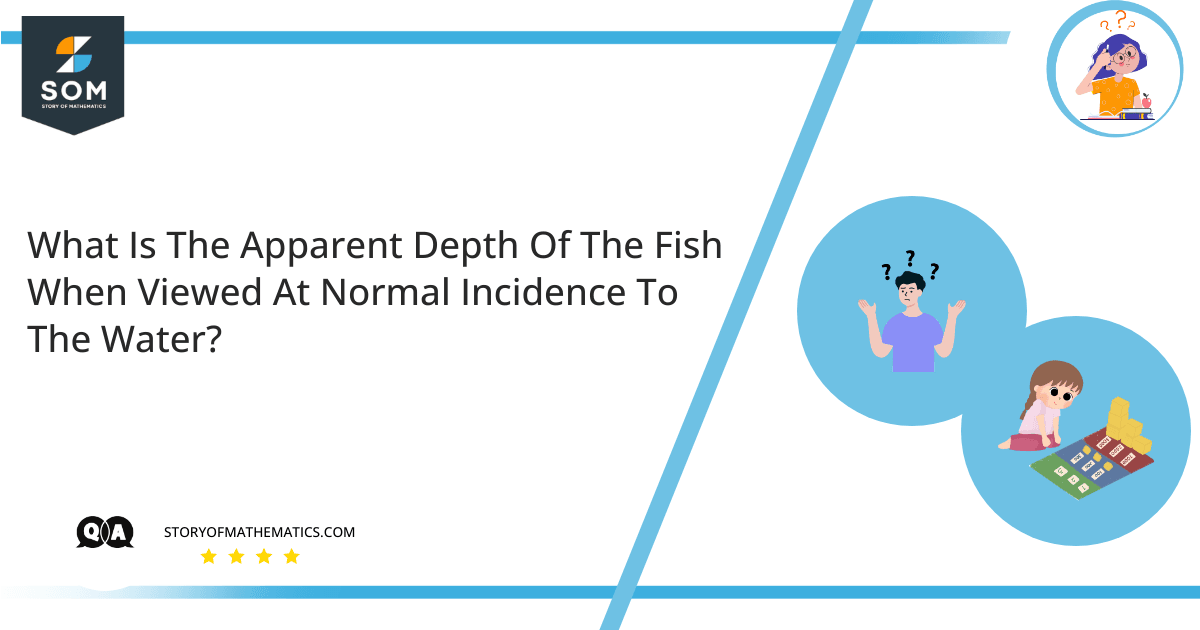
This question aims to find the apparent depth of a fish when it is floating motionless in the water and also the apparent depth of its image forming in the mirror at the bottom of the tank.
The concepts needed to solve this question are related to refraction in water. Refraction occurs when a light ray passes from one medium to another, given that both mediums have different refractive indices. Refraction is the bending of light rays towards the normal when passing from a medium with low refractive index to a medium with high refractive index and vice versa.
Expert Answer
In this problem, the given height of the water in the tank is:
\[ h_w = 20 cm \]
The real depth of the fish from the surface of the water is given as:
\[ d_f = 7 cm \]
We know the refractive indices of air and water are $1.00$ and $1.33$, respectively, which are given as:
\[ \eta_{air} = 1.00 \]
\[ \eta_{water} = 1.33 \]
a) To find the apparent depth of the fish, we can use the following formula:
\[ d_{app} = \dfrac{\eta_{air}}{\eta_{water}} \times d_f \]
Substituting the values in the above equation, we get:
\[ d_{app} = (\dfrac{1.00}{1.33}) \times (7) \]
\[ d_{app} = (0.75) \times (7) \]
\[ d_{app} = 5.26 cm \]
b) To find the apparent depth of the image of the fish floating without motion in the water can be calculated by the same formula as used before. Now the real depth of the fish will be different, so we can calculate that depth by following this formula:
\[ d_{img} = 2 \times h_w – d_f \]
Substituting the values, we get:
\[ d_{img} = 2 \times 20 – 7 \]
\[ d_{img} = 33 cm \]
Using this value to calculate the apparent depth of the image of the fish, we get:
\[ d_{app,img} = (\dfrac{\eta_{air}}{\eta_{water}}) \times d_{img} \]
\[ d_{app,img} = (\dfrac{1.00}{1.33}) \times 33 \]
\[ d_{app,img} = (0.75) \times (33) \]
\[ d_{app,img} = 24.8 cm\]
Numerical Result
The apparent depth of the motionless fish floating in the water at the real depth of $7 cm$ is calculated to be:
\[ d_{app} = 5.26 cm \]
The apparent depth of the image of the motionless fish floating in the water is calculated to be:
\[ d_{app,img} = 24.8 cm \]
Example
Find the apparent depth of the fish floating at a depth of $10 cm$ from the surface of water while the total depth of the water is unknown.
We know the refractive indices of air and water and the real depth of the fish. We can use this information to calculate the apparent depth of the fish when viewed at normal incidence. The formula is given as follows:
\[ d_{app} = (\dfrac{\eta_{air}}{\eta_{water}}) \times d_{real} \]
Substituting the values, we get:
\[ d_{app} = (\dfrac{1.00}{1.33}) \times 10 \]
\[ d_{app} = (0.75) \times 10 \]
\[ d_{app} = 7.5 cm \]
The apparent depth of the fish when floating at $10 cm$ from the surface is calculated to be $7.5 cm$.
